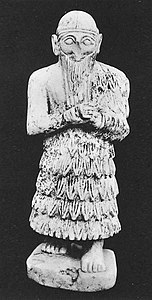Ishqi-Mari or Ishgi-Mari (𒅖𒄄𒈠𒌷 iš11-gi4-ma-rí),[5] previously read Lamgi-Mari,[6][1] was a King of the second Mariote kingdom who reigned c. 2350-2330 BCE. He is one of three Mari kings known from archaeology, Ikun-Shamash probably being the oldest one.[7] The third king is Iku-Shamagan, also known from an inscribed statue.
| Ishqi-Mari 𒅖𒄄𒈠𒌷 | |
|---|---|
| King of Mari | |
 Statue of Ishqi-Mari,[1] Aleppo National Museum. Here seen at an exhibition in the Institut du Monde Arabe, Paris in 2014.[2][3][4] | |
| Reign | c. 2350-2330 BCE Middle Chronology |
| King of Mari | |
In their inscriptions, these Mari kings used a dialect of the Akkadian language, whereas their Sumerian contemporaries to the south used the Sumerian language.[7]
It is thought that Ishqi-Mari was the last king of Mari before the conquest and the destruction of Mari by the Akkadian Empire under Sargon circa 2330 BCE.[8]
Inscriptions
Ishqi-Mari is known from a statue with inscription.[7] The statue is in the Aleppo National Museum.[1][9][10] The inscription on the back of the statue reads:
𒅖𒄄𒈠𒌷 / 𒈗𒈠𒌷 / 𒑐𒋼𒋛𒃲 / 𒀭𒂗𒆤 / 𒊨𒋤 / 𒀀𒈾 / 𒀭𒈹𒀴 / 𒊕𒄸𒁺ish11-gi4-ma-ri2 / lugal ma-ri2 / ensi2 gal / Den-lil2 / dul3-su3 / a-na / Dinanna-nita / sa12-rig9
"Ishqi-Mari, king of Mari, great ensi of Enlil, dedicated his statue to Inanna"
This inscription was instrumental in identifying Tell Hariri with the Mari of antiquity.[13]
Several cylinder seals with intricate designs in the name of "Ishqi-Mari, King of Mari" are also known.[14]
Discovery (23 January 1934)

The statue of Ishqi-Mari was discovered buried in the archaeological remains of the ancient city of Mari, in the Temple of Ishtar, by a French archaeological team led by André Parrot on 23 January 1934.[15][16]
The statue shows Ishqi-Mari with a long beard and parted and plaited hair. He wears a hairbun similar to the Sumerian royal hairbuns, such as on the headdress of Meskalamdug or reliefs on Eannatum.[1][17] He wears a fringed coat leaving one shoulder bare, a type of clothing also seen on contemporary Akkadian Empire depictions of rulers.[15]
- Ishqi-Mari statue (front)
- Ishqi-Mari statue (side)
- Ishqi-Mari statue (back)
In Aleppo museum
- Ishqi-Mari in profile. He wears a hairbun similar the Sumerian royal hairbuns, such as on the headdress of Meskalamdug or reliefs on Eannatum. The inscription is visible on the back of the right shoulder.[1]
- Statues from Mari. The statue of Ishqi-Mari appears partially on the left: it is much smaller than many of the traditional Mari statues.[1] Aleppo National Museum
- Ishqi-Mari (forefront, in profile), before larger figures.[1]
References
Wikiwand in your browser!
Seamless Wikipedia browsing. On steroids.
Every time you click a link to Wikipedia, Wiktionary or Wikiquote in your browser's search results, it will show the modern Wikiwand interface.
Wikiwand extension is a five stars, simple, with minimum permission required to keep your browsing private, safe and transparent.








